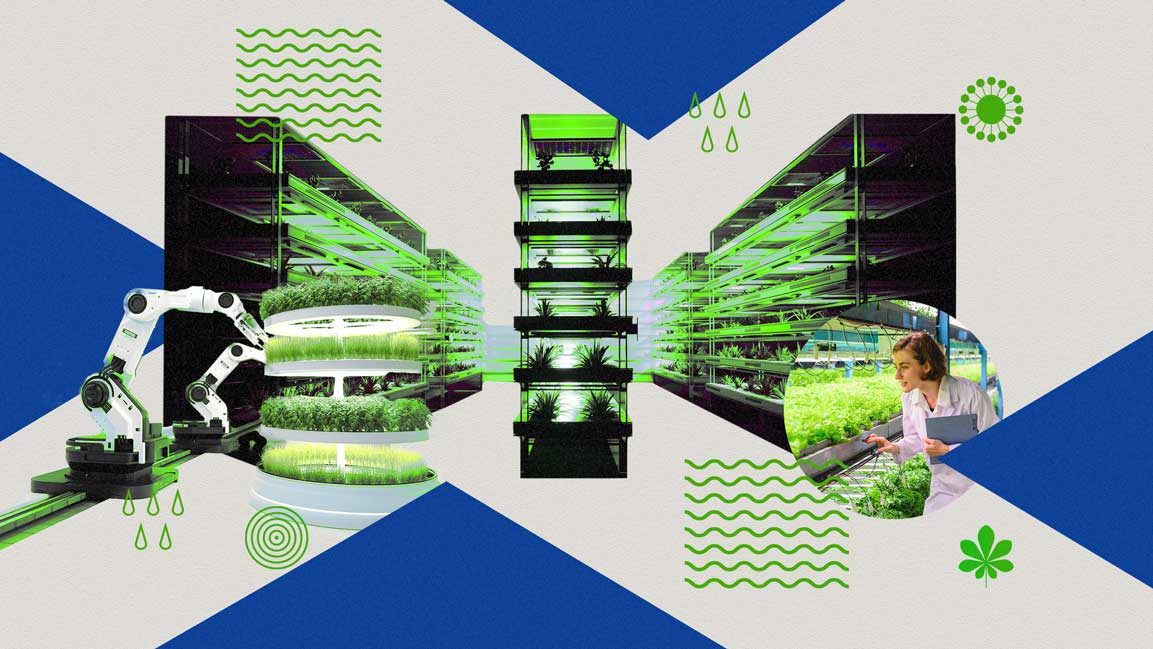- | 9:00 am
Are vertical farms the only way to future-proof agriculture in the Middle East?
Climate change is increasing the region's food security challenges. Could innovative agricultural solutions like vertical farms help?

As global populations and urban centers expand, the demand for sustainable food sources has never been more critical. In the arid regions of the Middle East, where traditional agriculture faces significant challenges due to water scarcity and extreme temperatures, vertical farming emerges as a transformative solution.
Many countries in the region depend significantly on food imports. For example, the UAE imports about 90% of its food, as the Ministry of Climate Change and Environment reported, and agriculture contributes only 0.1 % to its GDP. Similarly, Saudi Arabia relies on imports for up to 80% of its food consumption.
During the COVID-19 pandemic, faced with a shortage of local produce, Sumedha Sharma, CEO of Sokovo Nature Farms UAE, turned to indoor vertical farming. “The absence of locally sourced goods made us completely dependent on imports for everyday food items. We focus primarily on growing lettuce, leafy greens like kale, microgreens, and edible flowers.”
GAINING TRACTION
Heralded as the next step in food production, vertical farming is gaining ground in the region.
According to Abdel Rahman Alzubaidi, CEO of Ivvest, vertical farming optimizes space and reduces resource consumption, enabling the cultivation of fresh produce in urban environments.
“Vertical farming works best when integrated with indoor farming, which involves growing plants in fully controlled environments, like our facilities. This allows us to design growing lights illuminating all the plants and create ventilation systems that ensure optimal conditions for lighting, temperature, humidity, and nutrients,” says Alzubaidi.
“The benefits are significant: first, there’s no need for pesticides, and second, each plant is nearly identical, resulting in low waste and a higher likelihood that the market will purchase our products.”
Dr. Dalal AlGhawas, a lecturer at the University of Hong Kong and an expert in food security, says vertical farming works with challenging environmental conditions in arid regions, creating year-round farming.
“The methods are resourceful and utilize nutrients, water irrigation, materials, and technologies without relying on the natural environment. “
According to Dr. AlGhawas, establishing food security mandates is essential for enhancing investment opportunities alongside public-private partnerships and incentives to advance the vertical farming industry.
For instance, in 2022, Bustanica launched the world’s largest vertical farm in Dubai, co-developed by Emirates Flight Catering and Crop One Technology. The farm aims to produce around three tons of leafy greens daily using 95% less water than conventional agriculture.
Unsurprisingly, the UAE is emerging as a regional hub for hydroponic farming, supported by strategic investments, including $100 million from the Abu Dhabi Investment Office.
Emphasizing the importance of policies to support and promote vertical farming, especially hydroponic, Sharma says, “As an indoor farm operating year-round, our primary operational costs are electricity and water. Currently, there are no subsidies for the farming sector in Dubai. Providing subsidies and addressing the high operational costs could significantly boost the expansion of vertical farming in the region.”
In the era of climate change and AI, indoor vertical farms have the potential to generate sustainable green jobs while gradually lowering the cost of seasonal fresh produce. As the EV industry has developed, expanding vertical farming will create high-paying employment opportunities and economic advantages, says Stuart Oda, a pioneer of vertical farming and founder and CEO of Alesca Life, an agtech company.
“Alesca’s vertical farms can be set up in underutilized urban spaces such as warehouses and parking lots, helping to activate and revitalize neglected buildings and communities.
CHALLENGES IN SETTING UP VERTICAL FARMS
However, there are challenges in establishing vertical farms and hydroponic systems in arid regions. One major issue is product market fit; vertical farming products often come at a premium compared to organic produce, making competition difficult, especially in the UAE, where local hydroponic brands can offer lower prices than imported organic vegetables. “Additionally, vertical farms mainly produce crops like leafy greens, tomatoes, and berries, raising concerns about their relevance for food security in arid climates,” says Dr. AlGhawas.
Also, setting up vertical farms requires significant investment in capital and operating expenditures, including high energy costs and specialized labor. The shortage of skilled workers further underscores the need for educational programs to train the next generation of operators in this field.
Alzubaidi says the government’s and community’s involvement helps facilitate the success of innovative agricultural practices. The first step is to establish clear and straightforward regulations that facilitate the adoption of these technologies, particularly in urban areas. Additionally, creating financial products to support these technologies is crucial. Currently, most financing options in the agricultural market focus primarily on greenhouses.
According to Dr. AlGhawas, local communities must encourage B2B customers to adopt vertical farming products to meet the demand in hotels, restaurants, and catering. Allowing incentives or plans to diversify their portfolio by incorporating vertical farming items as a source of locally generated vegetables and sustainable agricultural techniques will help.
It’s also important to educate customers to understand and value the benefits of these products, which are pesticide, herbicide, and fertilizer-free. They are also locally sourced with a lower supply chain and transportation carbon footprint.
Alzubaidi says it’s essential to cultivate a new generation of talent in agriculture by updating university curricula to reflect current technologies and advancements. Making the industry more appealing to youth is vital, as agriculture is often viewed unfavorably.
“Many students who study agriculture do so as a last resort, resulting in a workforce that may not possess the required skills and experience. By modernizing agricultural education, we can better prepare young professionals to tackle the industry’s challenges and foster a more dynamic and innovative sector,” he adds.








































